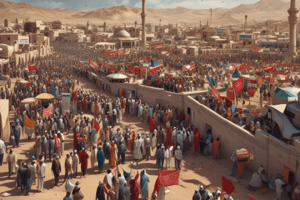Podcast
Questions and Answers
What event is considered the immediate catalyst for the Arab Spring?
What event is considered the immediate catalyst for the Arab Spring?
- The overthrow of Hosni Mubarak in Egypt.
- The self-immolation of Mohamed Bouazizi. (correct)
- The Libyan civil war.
- The resignation of Zine El Abidine Ben Ali.
Which of the following best describes the significance of the term 'Arab Spring'?
Which of the following best describes the significance of the term 'Arab Spring'?
- It reflects a season of widespread economic prosperity.
- It signifies a period of significant advances in agricultural technology.
- It alludes to a period of political and democratic liberalization. (correct)
- It is a name given to a series of coordinated military operations.
Which of the following was NOT a cause of widespread discontent during the Arab Spring?
Which of the following was NOT a cause of widespread discontent during the Arab Spring?
- The lack of advanced technological infrastructure. (correct)
- Authoritarian forms of rule
- Economic inequality and hardship.
- Widespread corruption within the existing governments.
What role did social media play in the events of the Arab Spring?
What role did social media play in the events of the Arab Spring?
What was one of the major, ultimately negative consequences of the Arab Spring in Syria?
What was one of the major, ultimately negative consequences of the Arab Spring in Syria?
Which of these leaders was NOT overthrown as a direct consequence of the Arab Spring?
Which of these leaders was NOT overthrown as a direct consequence of the Arab Spring?
What is a key takeaway from the Arab Spring regarding the nature of social revolutions?
What is a key takeaway from the Arab Spring regarding the nature of social revolutions?
Which country's revolution is regarded as the start of the Arab Spring?
Which country's revolution is regarded as the start of the Arab Spring?
Flashcards
Arab Spring
Arab Spring
A series of uprisings across the Middle East and North Africa in 2010-2011.
Mohamed Bouazizi
Mohamed Bouazizi
Tunisian street vendor whose self-immolation sparked the Arab Spring.
Zine El Abidine Ben Ali
Zine El Abidine Ben Ali
President of Tunisia who fled on January 11, 2011, after protests.
Social media's role
Social media's role
Signup and view all the flashcards
Egyptian Uprising
Egyptian Uprising
Signup and view all the flashcards
Libyan Civil War
Libyan Civil War
Signup and view all the flashcards
Syrian Civil War
Syrian Civil War
Signup and view all the flashcards
Impact of Arab Spring
Impact of Arab Spring
Signup and view all the flashcards
Study Notes
The Arab Spring
- A series of uprisings and revolutions occurred across the Middle East and North Africa in 2010 and 2011.
- The term "Arab Spring" alludes to the "Prague Spring" of 1968.
- The spark for the Arab Spring was the self-immolation of Mohamed Bouazizi, a Tunisian street vendor, on December 17, 2010.
- Bouazizi's protest was against Tunisian government harassment and confiscation of his unlicensed goods.
- Bouazizi's death ignited Tunisian protests, driven by social media and widespread discontent with government corruption and authoritarian rule.
- On January 11, 2011, Tunisian President Zine El Abidine Ben Ali, who ruled for 23 years, fled the country. This marked the start of the Arab Spring.
- Protests spread rapidly to Egypt, Libya, Syria, Yemen, and Bahrain.
- These uprisings were fueled by similar issues: authoritarian regimes, economic inequality, and corruption.
- Egyptian President Hosni Mubarak was overthrown after weeks of protests on February 11, 2011.
- In Libya, Muammar Gaddafi, who ruled for over 40 years, was overthrown and killed.
- The Arab Spring brought significant regime changes but also unpredictable and negative consequences.
- The Syrian Civil War was triggered by the Arab Spring, resulting in hundreds of thousands of deaths, a massive refugee crisis, and widespread instability.
- Social media was instrumental in mobilizing and amplifying the protest movements, yet social revolutions are complex and unpredictable.
- Outcomes varied across countries. Some uprisings led to reform, while others created instability and violence.
- The Arab Spring highlights the global interconnectedness, the power of protest, and continuous challenges relating to democratization and reform.
Studying That Suits You
Use AI to generate personalized quizzes and flashcards to suit your learning preferences.




